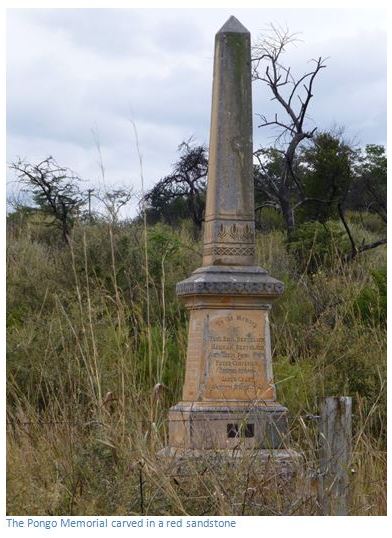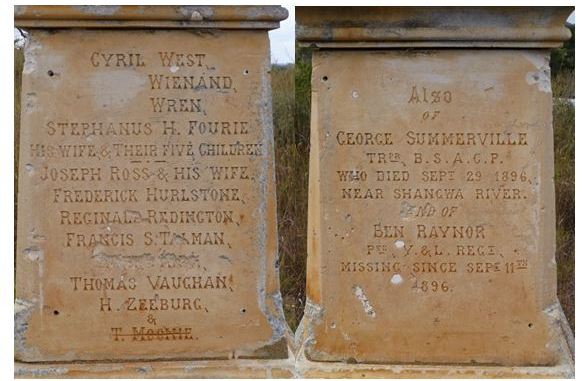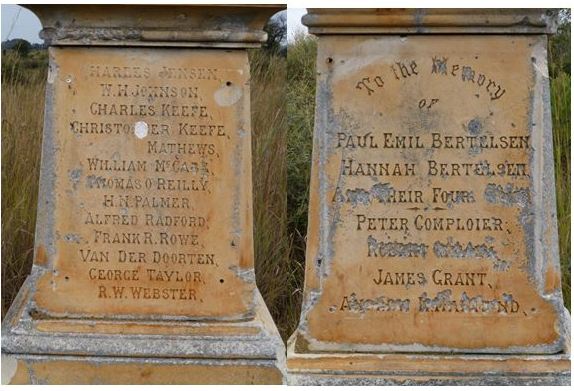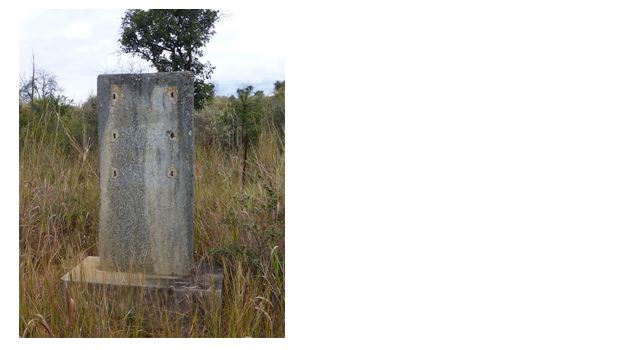Pongo Memorial (Matabele uprising, or First Umvukele, 1896)
- The obelisk shaped monument made of pink sandstone commemorates those civilian prospectors, traders and farmers (32 men, 4 women and nine children; 45 in all) who were killed in the area during the 1896 Matabele rebellion.
- Easy access to the historical site off the main highway.
From Bulawayo: take the A5 towards Gweru, pass Shangani, 0.9 KM before crossing the Shangani River bridge turn right onto the old single tar road leading down to the low level bridge. The Pongo Memorial is on the left about 200 metres from the tar road.
From the Zimbabwe Military museum in Gweru take the A5 towards Bulawayo, 56 KM pass the Shangani River bridge, 56.9 KM turn left at the top of the rise onto the old single tar road leading down to the low level bridge, 57.1 KM Pongo Memorial is on the left about 200 metres from the tar road.
GPS reference: 19⁰44′52.16″S 29⁰24′26.47″E
The Memorial is situated to the west of the Shangani River Bridge and it’s a mystery why it is called the Pongo Memorial, as the Pongo River is sited about 15 kilometres to the west. However, a number of the victims were killed at the Pongo store on the river, and this probably accounts for the name. The Memorial is certainly neglected and overgrown and has to be searched for before it is found. This is part of the graphic account in FC Selous’ Sunshine and Storm describing the scene when Earl Grey, who had replaced Dr Jameson as the Administrator of the BSA Company, arrived at the Pongo store.
List of Victims named on the Pongo Memorial | ||
Names | Date of Death | Details |
Barr, W.A. | End March | killed at Shangani. His name is almost indecipherable on the Pongo Memorial |
Bertelsen, Paul Emal, wife Hannar & 4 sons | End March | killed at Shangani, farming 12 miles north of Hartley Hills road |
Comploier, Pete | 26-Mar | killed at Shangani, prospector |
Fourie, Stephanus and his wife and their five children | 02-Apr | killed at Tekwe River, farming |
Gracey, Robert | End March | from Ireland, Ex BSAP & prospector killed with his coloured wife, whose name is omitted from the Memorial, perhaps a sign of the times. His name is almost indecipherable. |
Grant, James | End March | killed at Shangani |
Hammond, Andrew Robert | 30-Mar | Engineers, killed together with Johnson, WH and Palmer, HN, his name is almost indecipherable on the Pongo Memorial |
Hurlstone, Frederick | End March | killed at Pongo River Hotel and store |
Jensen, Charles | 30-Mar | killed at Shangani, Swedish |
Johnson, WH | 30-Mar | Engineers, killed together with Hammond, AR and Palmer, HN |
Keefe, Charles | End March | killed at Shangani, together with his brother Keefe, C and Webster, RW |
Keefe, Christopher | End March | killed at Shangani, together with his brother Keefe, C and Webster, RW |
Mathews, Benjamin | 30-Mar | Jewish from Melbourne, killed at Shangani with Van der Doorten |
McCabe, William | End March | killed at Shangani, was ex 6th Inniskilling Dragoons, listed as Jock Thomas in the BSA Company reports, partner of George Taylor |
Moonie, T |
| His name is on the Memorial, but he was not listed as killed in BSAP Company report. His name on the Memorial has a line cut through it, apparently by him some years later |
O’Reilley, Thomas | End March | killed at Shangani on Leechdale Co.’s property |
Palmer, HN | 30-Mar | Engineers, killed together with Johnson, WH and Hammond, AR |
Radford, Alfred | End March | killed at Shangani, partner of Frank Leech |
Raynor, Ben | 11-Sep | killed at Shangani, private in The York and Lancaster Regt. |
Redington, Reginald | End March | killed at Pongo River, assistant in Hurlstone's store |
Ross, Joseph and his wife | 02-Apr | killed at Tekwe River, farming |
Rowe, Frank R | 30-Mar | killed at Shangani, miner from St Austell |
Summerville, George | 29-Sep | Died from pneumonia, Shangani, Trooper, F Troop BSA Company Police |
Talman, Francis S. | End March | killed at Hurlstone's store on Pongo River, listed as Frank in the BSA Company reports |
Taylor, George | End March | killed at Shangani, formerly in the Royal Navy, real name George John Zeall, partner of William McCabe |
Van der Doorten | 30-Mar | Jewish from Holland, killed at Shangani, with Mathews |
Vaughn, Thomas | 25-Mar | killed at Pongo River |
Webster, RW | End March | killed at Shangani, together with the Keefe brothers |
West, Cyril | End March | killed at Inyati with Bolton, R.W who is not listed on the Pongo Memorial site, but is listed as killed in the BSA Company reports |
Wienand | End March | killed at Shangani, Cattle inspector |
Wren | 25-Mar | killed at Shangani, Cattle inspector |
Zeeburg, H | 26-Mar | killed at Pongo River, trader |
Another memorial within the fenced area was to Caesar Barrand Hull DFC.
After some research, the mystery of this missing plaque next to the Pongo Memorial was unravelled. It had been erected before the end of World War II and reads:
TO THE MEMORY OF A BRAVE MAN
Squadron Leader CAESAR BARRAND HULL DFC (Royal Air Force)
BORN AT LEACHDALE FARM, SHANGANI 26TH FEBRUARY 1914
KILLED IN ACTION OVER LONDON 7TH SEPTEMBER 1940
�WE HONOUR THE BRAVE�
Caesar Hull was born in Shangani and educated at St. Johns College, Johannesburg. Flying was his passion like many others of his generation. He travelled to England in 1935 and completed his flying course before being posted to 43 (F) Squadron at Tangmere for flying duties. Much more detail of his fascinating life is contained on the ORAF website. The squadron was renowned for its aerobatics shows with the most notable display being at Hendon on the coronation of King George VI in 1937 in front of 250,000 people in which Caesar Hull won the individual aerobatics event.
By 1938 the squadron with its Hawker Furies was preparing for war with Germany, but it was realized the Furies were no match for the Luftwaffe and by 1939 they were replaced by Hawker Hurricanes. The German attack on Poland resulted in a British ultimatum and war was declared on 3rd September 1939. The squadron was posted to Acklington, near Newcastle to protect the coastal convoys from enemy attack. Caesar Hull shot down a Heinkel (He 111) bomber on 3rd February, 43 Squadron’s first “kill”.
The squadron was transferred to Wick to help protect the home Fleet at Scapa Flow where on 28th March he took part in a joint attack which claimed another He 111. On the 10th April, he was part of a joint attack which shot down another He 111.
In May, Caesar was transferred to 263 Squadron as Flight Commander. They were equipped with Gladiators, an obsolete biplane fighter and destined for Norway on the aircraft carrier HMS Furious. On 24 May, Hull in a joint operation shot down a He 111. On 26 May, he shot down another He 111 and on the same flight, shot down a Junkers (JU 52) transport, followed by two more Ju 52’s and damaging a He 111. In one afternoon, in an obsolete aeroplane, he destroyed four enemy aircraft and seriously damaged another. On 27 May, he shot down a Junkers 87 Stuka, but his Gladiator was attacked and damaged by a ME 110 and crashed, with Caesar being wounded in the head and knee. He was evacuated back to the UK from Norway where he was awarded the Distinguished Flying Cross.
Caesar recovered and was posted to 43 Squadron at Tangmere in August, back onto Hurricanes. He was promoted to CO, when the previous CO was killed in action. There was no one better suited to revive morale. On the 4 September, 43 Squadron shot down eight ME 110’s against one Hurricane damaged, and Caesar had two more kills.
On 7 September, a massive raid comprising 350 bombers and 600 plus fighters headed straight for London. 43 Squadron led by Caesar Hull flew directly towards the massed formations. In the resulting confused melee, it was reported that Caesar shot down two Dornier 17’s and used all his ammunition before being shot down and killed. He had been killed by a bullet during the battle over the London Docks and was found dead beside his Hurricane in the grounds of a boy’s school in Purley, Kent. He was buried at St. Andrews Churchyard at Tangmere.
After his death, the citizens of Shangani clubbed together and erected the memorial in his honour.
Many years later the new road was built with the old road by-passed and the monument became less accssible, overgrown, and forgotten about. Most metal plaques in Zimbabwe during this time were being stolen and sold for scrap, so the Hull Family decided to retrieve the metal plaque and donate it to the Tangmere Aviation Museum. The plaque was so well embedded that they had to resort to using a 14lb hammer to remove it, which accounts for the shattered state of the granite plinth. The plaque was finally delivered and handed over by his sister to Tangmere Aviation Museum, the war-time aerodrome from which Caesar Hull flew, on Saturday 17 April 2004.
Acknowledgements
F.C. Selous. Sunshine and storm in Rhodesia; being a narrative of events in Matabeleland both before and during the recent native insurrection up to the date of the disbandment of the Bulawayo field force. Rowland Ward & Co. 1896




